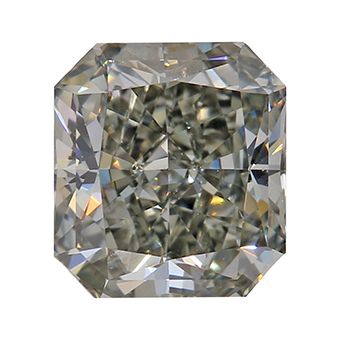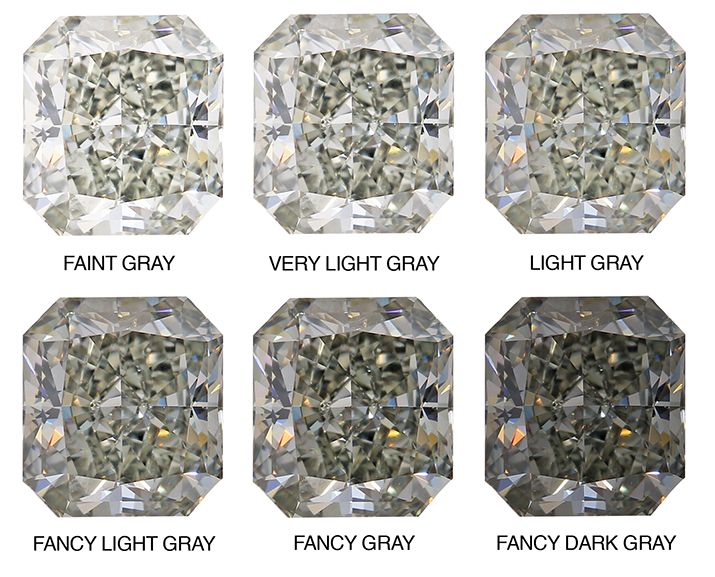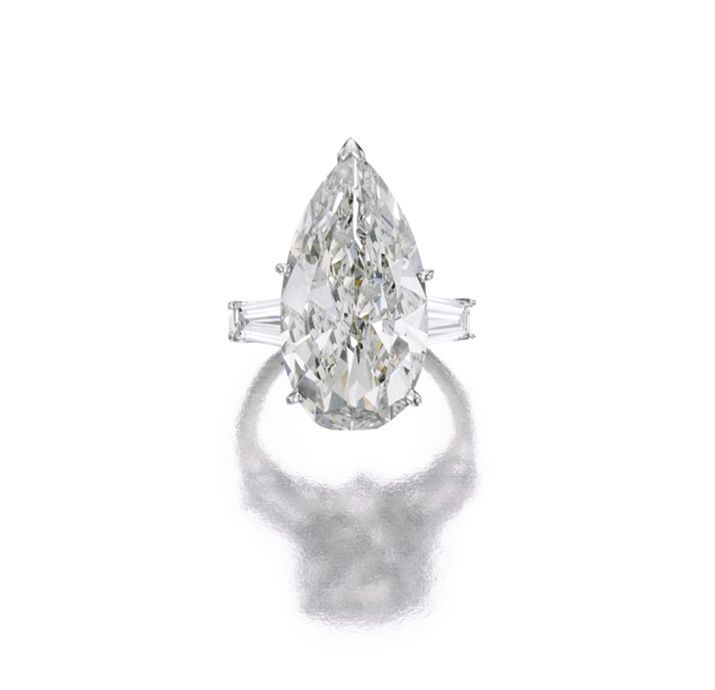Gray Diamond Quality Checklist
- Color Grade: Fancy
- Clarity Grade: SI
- Symmetry: Good to Excellent
- Polish: Good to Excellent
- Fluorescence: None to Faint

The rich slate of a summer thundercloud. The bright silver of a trout flashing in a stream. The elegant dove gray of a heavy silk dress. The steel of an art deco skyscraper. There are many more than 50 shades of gray diamonds, from the palest platinum gray to dark charcoal and every shade in between.
Gray diamonds are the ultimate neutral, subtle and sophisticated, for the minimalist in all of us. Until recently, gray diamonds were overlooked by fancy colored diamond collectors who looked only for yellow, pink and blue diamonds. But a new generation of jewelry connoisseurs in search of something unusual, individual and unconventional, have made fancy gray diamonds appreciate considerably in value.
A 10.17-carat pear-shaped fancy gray diamond sold for $454,000 at Sotheby’s in 2015.
In addition to fancy gray diamonds with a gray body color, today women are also attracted to salt and pepper diamonds: diamonds with a gray body color that are sprinkled with black and gray inclusions that give them personality. Salt and pepper diamonds are often rose cuts that have a softer sparkle than the traditional round brilliant cut. These one of a kind gems contain landscapes and constellations all their own.
Fancy gray diamonds today are similar in price to colorless diamonds but are much more rare. Jewelry designers are creating one of a kind fancy gray diamond rings. It’s easy to see why fancy gray diamond engagement rings are becoming more popular: even a classic engagement ring setting becomes unique with a gray diamond.
Fancy gray diamonds are a symbol of mystery, magic and calm. The meaning of gray diamonds is individuality and an ability to transcend conventional thinking and uncover something new.
In diamonds, gray often occurs in combination with other colors. Some of the most famous blue diamonds are actually a grayish blue, including the fancy dark grayish blue Hope Diamond.
Like blue diamonds and violet diamonds, gray colors are thought to be related to traces of hydrogen and boron in the diamond’s crystal structure. Gray diamonds, along with blue diamonds, conduct electricity, unlike all other diamond colors.
Fancy gray diamonds are found in Australia, South Africa, India, Russia, and Brazil. While it’s known for its pink diamonds, Argyle mine in Australia also produces gray diamonds, including the pale gray colors known as Silvermist gray diamonds.
When buying a fancy gray diamond, the most important quality factor to consider is the color. While GIA grades standard colorless diamonds by the absence of color from the completely colorless D to the noticeably tinted Z, these rules only apply for the standard colorless to yellow diamonds. If gray diamonds are almost colorless, they fit into the standard color grading system.
But once the color intensity of gray diamonds reach the equivalent of a K color grade, they are graded as gray diamonds, not colorless diamonds. Diamonds with a color intensity of K-M will be called faint gray diamonds. Diamonds with a N-R color grade and a gray tint will be called very light gray diamonds. Diamonds from S to Z are called light gray diamonds. Fancy light gray diamonds begin beyond Z. A darker gray tone is called Fancy Gray and even darker gray is called Fancy Fancy Dark Gray.

Gray diamonds can also have a secondary hue, most commonly green gray, greenish-yellow gray, brown gray, blue gray or violet gray. The last color mentioned on a GIA report is the dominant color. The GIA uses an adjective for the color when the secondary color is slight and a noun for the color when it is more apparent. So a greenish gray diamond is primarily gray with a slight modifying tone of green but a green gray diamond, although still primarily gray, has a more noticeable green tint. Small differences in color can result in large price differences. Gray diamonds with blue, violet, and green secondary colors are worth more than gray diamonds with no secondary colors. Gray diamonds with brown secondary colors are worth less.
That’s why it’s so important to have a GIA Colored Diamond Grading Report. GIA has graded virtually every significant fancy colored diamond on the market: only GIA’s description of a fancy diamond’s color is trusted by the market when it comes to pricing fancy colored diamonds.
Having a report from GIA also confirms that a gray diamond’s color is natural, that the diamond hasn’t been treated and that that the diamond is not laboratory grown.
Unlike colorless diamonds, which are most often cut into round brilliant cuts, gray diamonds are most often found in fancy shapes like oval cuts, cushion cuts, radiant cuts, pear shapes, and emerald cuts. That’s because the round brilliant cut tends to dilute the color of gray diamonds.
Gray Diamond Quality Checklist

The style of your engagement ring setting can make your gray diamond look more or less gray. Even if your diamond is fancy light gray, you can make the color look more saturated by contrasting the gray with white diamonds. The contrast effect means that halo gray diamond halo engagement rings are a popular choice. Three-stone engagement rings with a gray diamond center stone and white diamond side stones are another way to add contrast and make the color of your gray diamond look richer.